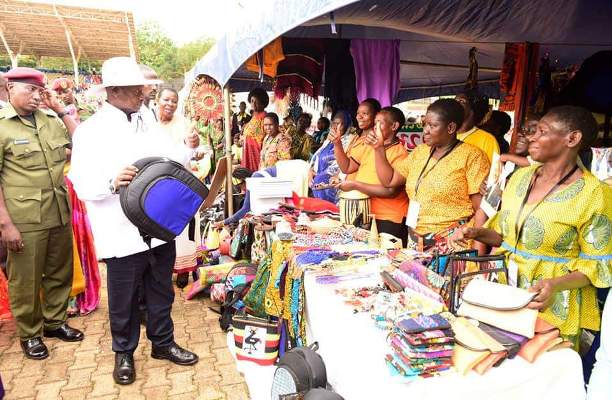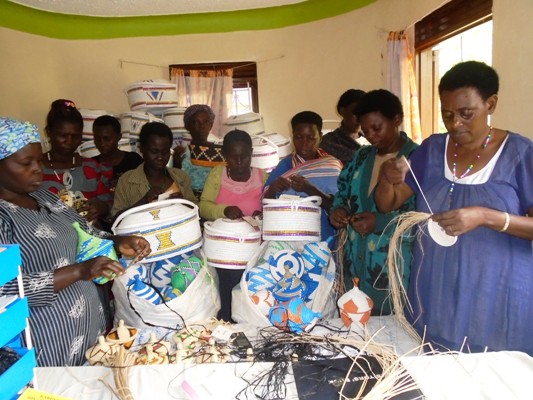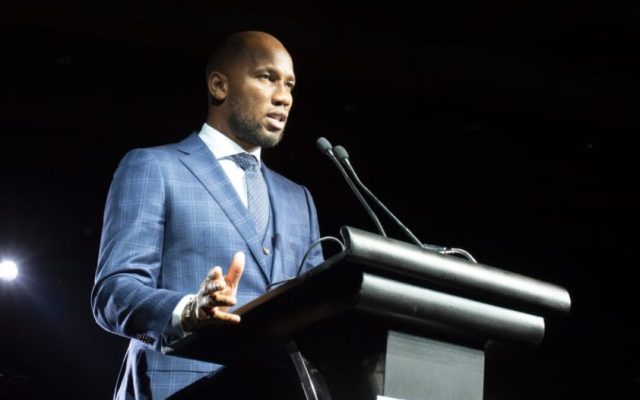Some of the beneficiaries of Uganda Women Entrepreneurship Programme in Rwenzori region showcasing their products
It is a public secret that when the National Resistance Army (now National Resistance Movement-NRM) captured power in 1986 after a five-year guerilla war, they inherited an economy that had literally collapsed.
Businesses had collapsed so much that it was common finding one huge village with a single tinny retail shop!
This meant that people had to stock essential items like salt and soap in advance because the shop could easily run out of items. Such shops would take long to restock.
This was mainly because the environment wasn’t conducive. The status-quo has since changed, with a number of small businesses thriving and boosting the economy.
As the NRM celebrates its 34th anniversary on Sunday 26th January 2020, Business Focus looks at the progress Micro, Small and Medium Enterprises (MSMEs) have made over the last three decades.
SMEs are unsung heroes that contribute immensely to the growth of the economy.
According to Uganda Investment Authority (UIA), a ‘Micro Enterprise’ is an enterprise employing up to four people, with an annual sales/revenue turnover or total assets not exceeding Shs10 million.
On
the other hand, Small Enterprises employ between 5 and 49 and have total assets
between Shs10 million but not exceeding Shs100 million.
The Medium Enterprise therefore, employs between 50 and 100 with total assets of
more than Shs100 million but not exceeding Shs360 million.
It is worth noting that the full liberalisation of the economy in 1990s coupled with peace and general stability have contributed substantially to Uganda’s good growth figures.
Uganda has experienced average annual growth of slightly over 6% in the past 30 years. Additionally, the economy is generally stable, with annual inflation averaging 6.3% from 1998 until 2019.
The above factors have been conducive to the growth of Uganda’s SME sector.
According to a 2015 National Small Business Survey of Uganda report by Financial Sector Deepening Uganda (FSDU), MSMEs collectively constitute about 90% of private sector production and employ over 2.5 million people.
Additionally, recent studies show that SMEs contribute over 25% to Uganda’s total Gross Domestic Product (GDP) and employ about 45% of the labour force.
According to figures from Uganda Revenue Authority (URA), domestic revenue contribution has been recorded at Shs7.57 trillion, Shs9.08 trillion and Shs9.74 trillion in 2016/17, 2017/18 and 2018/19 respectively.
The tax body says SMEs tax contribution to the domestic revenue has been remarkable at Shs2.55 trillion, Shs3.03 trillion and Shs3.54 trillion in 2016/17, 2017/18 and 2018/19 respectively.
Doris Akol, the URA Commissioner General highlights the importance of SME sector to Uganda’s economy.
“SMEs are important for their contribution to employment, economic growth, innovations and the diversity of competition they bring to the markets. SMEs guarantee inclusiveness and sustainable economic growth,” Akol said at a recent press briefing.
She said the total number of SMEs on her register is 376,657. Majority are in the wholesale and retail trade sector. It is also important to note that many SMEs still operate informally.
In terms of employment, URA says taxpayers in the SMEs category were employing 337, 099 people in 2016/17, 417, 652 in 2017/18 and 419 713 in 2018/19.

“Supporting SMEs boosts their growth, which would have a ripple effect on the entire country. We pledge to offer specialized taxpayer education services, knowledge and skills for effective business management, creating effective networking to name but a few,” Akol said.
SMEs Journey
Charles Ocici, the Executive Director at Enterprise Uganda, an entity nurturing businesses, says Uganda’s SME segment has been growing over the last 30 years, but survival of small and medium enterprises remains a big challenge.
He gave a few examples of Ugandan owned businesses that have grown into big companies in the last 30 years. These include Mulwana Group of Companies, Mandela Group and Oscar Industries.
Wavamuno and Ssebagala and Sons have since lost dominance. Many other small and medium enterprises have either collapsed or been sold to foreign owners.
Ocici adds that a number of Ugandan owned pioneer restaurants including Kibo, Nile Grill, Tender Grill, Kentenky and Majestica have also disappeared.
Pioneer private schools like Bweyogerere progressive and Kampala Parents have since changed ownership because of the owners’ inability to run them, coupled with unmanageable huge bank debts.
In the banking sector, all indigenous banks such as Teffe Bank, International Credit Bank Limited, Greenland Bank, National Bank of Commerce (NBC) and Crane Bank Limited have all collapsed with little or no efforts made to save them.
He added that a number of Ugandans were involved in coffee processing and exportation when NRM came to power but the business is now dominated by foreign investors.
“Government should know that creating a business that survives generational change is hard; government needs to do more to build capacity of businesses that can stand the test of time,” Ocici says in an exclusive interview with Business Focus.

Constraints to growth
The 2015 National Small Business Survey of Uganda report by FSDU indicates that the key constraint to growth for MSMEs is financial.
They centre on both ‘limited access to finance’ (74.3%), and the ‘cost of finance’ (73.2%).
Tax, roads, electricity, the broader macroeconomic environment, access to land and corruption are the other constraints felt by over half of the respondents to the survey.
“It is clear from the survey that a fundamental challenge is the extent to which commercial banks and other financial institutions have stringent requirements around security (collateral) which MSMEs are not able to meet,” the report reads in part.
What Government Should Do
Ocici says government should give business development services attention if SMEs are to sustain growth. He says there are five pillars that SMEs should address if they are to grow and survive the test of time. These include leadership and governance, human resource management, aggressive marketing, customer care and access to finance.
“It is good to give SMEs government business,” he said,“but before you do so build their capacity,” he adds. For instance, Ocici said that Zzimwe Construction Limited was a big local construction company but it didn’t have capacity to survive.
“The company didn’t have good corporate governance practices in place. Once it started getting government business, it collapsed,” Ocici says.
He adds that the Buy Uganda Build Uganda (BUBU) Policy can’t succeed without first dealing with the above five pillars of business sustainability.
“Government should also encourage joint venture partnerships between Ugandan SMEs and foreign investors,” he says, adding that government should also strengthen the domestic commercial and development banking sector with the aim of lowering interest rates.
He says government should continue recapitalizing Uganda Development Bank and let it function independently.
Ocici says the quality of a country’s SMEsector determines the quality of its Foreign Direct Investments (FIDs).
“SMEs also determine the quality and depth of your banking sector. They also determine the quality of the job market,” he says, adding that SMEs also determine the competitiveness of a country.
He gave an example of BIDCO and Mukwano that buy land, cultivate and process without big support from local farmers.
“That shows inefficiency. Crop production should mainly be handled by farmers as BIDCO and Mukwano focus on value addition,” he says.
He adds that the variety of funding solutions also depends on the quality of SME segment.
Gov’t Programs supporting SMEs
To address some of the constraints facing SMEs especially financial challenges, government has come up with a number of programs aimed at supporting the growth of SMEs in the country.
Agriculture Credit Facility
The Agriculture Credit Facility (ACF) was set up by the Government of Uganda (GoU) in partnership with Commercial Banks, Uganda Development Bank Ltd (UDBL), Micro Deposit Taking Institutions (MDIs) and Credit Institutions all referred to as Participating Financial institutions (PFIs).
The facility is intended to provide medium and long term loans to projects engaged in agriculture and agro-processing on more favourable terms than are usually available from the PFIs.
The scheme is administered by the Bank of Uganda (BoU), with provision for a maximum grace period of 3 years and the interest rate to the final borrower being a maximum of 10% per annum.
The maximum loan amount to a single borrower is up to Shs.2.1billion. However, this amount can be increased up to Shs.5billion on a case by case basis (for eligible projects that add significant value to the Agriculture sector and the economy as a whole).
There is no designated minimum loan amount to the final beneficiary (farmer/ agro-processor), but BoU can only reimburse a minimum of Shs10million to the PFIs.
The maximum loan period should not exceed 8 years and the minimum should be 6 months.
Youth Livelihood Funds
The Shs256bn Youth Livelihood Fund is managed by Ministry of Gender, Labour and Social Development and State House under the Youth Livelihood Programme (YLP).
Launched in 2013 by President Yoweri Museveni, YLP is aimed at addressing unemployment challenge in Uganda.
Funds are provided through Youth Interest Groups (YIGs) of 10-15 people in form of revolving funds (soft loans with friendly terms).
What is important to know about this programme is that there’s no interest for repayments made in the first 12 months and no physical assets or collateral is required.
However, only 5% per annum surcharge is repaid after the initial 12 months. The fund size depends on request made by the group ranging from Shs1m to Shs25m.
Women Fund
In 2015, the Government of Uganda introduced the Uganda Women Entrepreneurship Programme (UWEP) aimed at improving women’s access to financial services, equipping them with skills for enterprise growth, value addition and marketing of their products and services.
Women are availed interest-free credit to initiate or strengthen their enterprises.
Like Youth Livelihood Programme, the Shs53bn UWEP is implemented under the Ministry of Gender, Labour and Social Development and seeks to accelerate the entrepreneurial acumen of Ugandan women while empowering them for economic development.

Innovations fund
Last year, President Yoweri Museveni directed that a fund be created for ICT innovation. The Shs15bn annual fund aims to facilitate the development of ICT innovations in Uganda. For innovators especially in ICT, this fund is for you.






